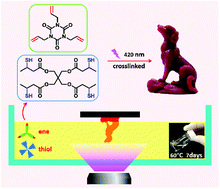Highly stable thiol–ene systems: from their structure–property relationship to DLP 3D printing
Abstract
Thiol–ene photopolymerization has been widely applied in polymer synthesis and the fabrication of optical devices via 3D printing due to its unique features such as low shrinkage stress and yielding homogeneous networks. However, the poor storage stability and unpleasant odor of conventional primary thiols have limited their application. Detailed evaluation of the photocuring properties of secondary thiols with low odor and good shelf-life stability is lacking. In this study, we systematically discussed the thermal storage stability, photopolymerization kinetics, and mechanical, thermal, and physical properties of three types of multifunctional secondary thiols and one type of primary thiol. The results show that all secondary thiol–ene systems exhibit better thermal storage stability (>7 days) at 60 °C than the primary thiol–ene system (<3 days). The primary and secondary thiol–ene networks with equivalent functionality and similar structures exhibited comparable reactivities and properties. The physical and mechanical properties of the thiol–ene networks can be adjusted by altering the functionality and stiffness of the secondary thiols. Compared to the traditional acrylate system with a shrinkage of 13.9%, the secondary thiol–ene systems exhibited a lower shrinkage of 7.6%. Furthermore, with optimized parameters, the secondary thiol–ene systems can be applied to digital light processing (DLP) 3D printing to fabricate objects with a vertical resolution of 50 μm. The proposed thiol–ene systems with high refractive indexes (>1.54) show great potential for the fabrication of 3D optical devices with high resolution.



 Please wait while we load your content...
Please wait while we load your content...